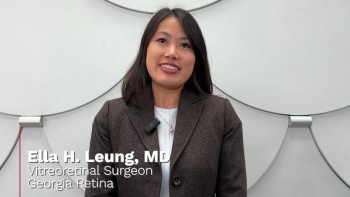
Internet glasses shoppers and loaves of banana nut bread
Are you wondering if other practices are charging for adding pupillary distance (PD) to prescriptions and adjusting glasses purchased online for free? If so, how does this fit into your mission statement and strategic goals?
Editor’s Note: Welcome to “
Are you wondering if other practices are charging for adding pupillary distance (PD) to prescriptions and adjusting glasses purchased online for free? If so, how does this fit into your mission statement and strategic goals?
I’m reminded of my neighbor’s college-age daughter and my banana nut bread. She loves it so much that she asked her mother to get the recipe. I gladly provided it and her mom thought I had left out the “secret sauce” because her daughter prefers mine to her own.
Internet glasses shoppers
Throw out the advice that the customer is always right. There are three different ways to provide a PD measurement to patients who take their prescriptions, purchase eyewear from somewhere else, and then bring the eyewear to you for adjustments.
- Financial Impact
If your cost of goods is calculated properly and it is 33% or lower, then your complimentary services are not hurting your bottom-line. This metric suggests that patients who want to purchase eyewear are waited on promptly. Consumers express displeasure by leaving the building. Patients are less likely to become annoyed when they are attended to, so employees should always provide a patient with a PD.
- Employee Morale
Disney business leadership courses often emphasize the importance of employee happiness. Often, providing PDs and adjustments to patients who purchased eyewear elsewhere annoys optical employees. The emotion attached to the task is the real issue. Mac Anderson (founder of Simple Truths and Successories Inc.) might say you can’t send this optical duck to eagle school.
So, do your employees have a bad attitude or should you “fire the patients”? This speaks to office culture. How does your practice’s core values suggest this issue be handled? If your office charges patients who are late for exams a fee, then I suspect that charging patients for PDs is something that in all fairness might be considered
On the other hand, the auto refractor used during pre-testing provides a PD without overloading busy opticians.
Your employees wanting to drop tasks without a change in job description might mean that both they and you need to re-read your employee policy manual or handbook. If it is not legally, morally or ethically inappropriate the question becomes one of office harmony and profitability versus what an employee wants to do or his or her preference.
- Your Practice’s Brand
If you haven’t thought about your practice brand, here is your chance. An Internet search of healthcare branding advice confirms that both big and little issues influence the patient.
Adjectives like “friendly” and “helpful” describe someone who does something for nothing. In Louisiana and other Gulf states the word “lagniappe” could be used to describe the practice of giving a patient who pays for an eye-health examination their PD and adjusting eyewear purchased somewhere else.
Especially in Louisiana, “lagniappe” is a way of thanking customers for their patronage. It came from the Spanish word “la ñapa,” which means “free bonus.”
In a book published in 1883 by Mark Twain, there was a section regarding the custom of giving patrons something for free when asked for lagniappe. There are still grocery chains and bakeries in 2018 that pass out cookies and donuts to children with their parents. Deli departments offer samples of meats and cheeses to patrons while their orders are being cut, weighed and wrapped.
It is said that shopkeepers tried to put an end to the practice of lagniappe in the 1800s, but the people strenuously objected. They had no choice but to keep giving a little something extra. (It is not certain whether this story is true.)
Although the tradition of a free gift is not nearly as widespread as it once was, it is still observed in optical dispensaries. Stop giving patients their PDs (which are not by law included in their prescription) and they may join their ancestors and object strenuously.
The secret to my banana nut bread
Because baking isn’t something I do all the time, I’m a lot like you. You perform more exams and surgeries than your optical sells glasses.
When I bake I want to make a good impression. I use quality ingredients and always start with fresh. (I admit I have no choice but to use fresh because the baking powder and baking soda usually expire between batches of bread.) I typically begin my baking session by watching a few instructional videos on America’s Test Kitchen, or a cooking show.
My neighbor, also named Donna, tells me she bakes all the time and just doesn’t understand why her family prefers my finished product. She is using my recipe!
Attention to detail has turned my neighbors into raving fans of my cooking. They talk about it and look forward to their free mini-loaves at Christmas. (This year, I skipped Christmas and made chocolate chip zucchini muffins in June.)
My neighbors like me. You want your patients to like you. My neighbors say nice things about me. You want your patients to say nice things about you. I didn’t put my son through college or fund my retirement accounts baking. Optical is a revenue stream that will never equal the combined surgical and clinic revenue of the practice. However, the good will that it creates will be something that you can bask in all year long. (My family thinks it is hilarious that neighbors wait on my food gifts. THEY know the truth.)
And now you do, too!
Just like I don’t give my neighbors the ingredients for my yummy treats, giving patients a PD for new eyewear isn’t enough to allow them to experience the awesome sauce of quality lenses. In fact, eyewear that provides clear, sharp vision has your opticians taking and passing along to the lab about as many measurements as my not-secret-at-all recipe has ingredients.
So, quality is hard to communicate in one sentence and surely this is a time management issue, maybe? Consider educating the patient about your quality eyewear (7 Reasons Why... pictures and quick bullet points) with a brochure when you hand the budget-minded patient “just the PD.”
Another low-cost/no-cost idea is to ask your spectacle vendor for a brochure about their patented, branded lenses versus private label/no name knock-off. Give this to the patient with a friendly smile.
Newsletter
Don’t miss out—get Ophthalmology Times updates on the latest clinical advancements and expert interviews, straight to your inbox.





















































.png)


